Author: EarnBIT, Translation: Vernacular Blockchain
In April 2024, Bitcoin will undergo another halving, an event that occurs every four years to cut miner rewards. The evolution of market structure supports the widely expected rise. This halving cycle is fundamentally different than before, and our guide summarizes common price predictions and unique drivers.
1. Bitcoin’s halving cycle
The halving reward will correspondingly reduce the number of newly mined Bitcoins. This happens after every 210,000 blocks, creating a four-year price cycle. Previous halvings occurred in 2012, 2016 and 2020.
"The total issuance will be 21,000,000 coins. They will be distributed when network nodes generate blocks and will be halved every four years. First four years: 10,500,000 coins. Next four years: 5,250,000 Coins. Four more years: 2,625,000 coins. Four more years: 1,312,500 coins. And so on..." — Satoshi Nakamoto, Cryptozoology Mailing List, January 8, 2009
This event will reduce profitability for miners, who use custom hardware (Application Specific Integrated Circuits, ASICs) to process transactions. According to CoinDesk, mining a block profitably will require at least $10,000 to $15,000 in 2023. After the halving, the cost could surge to $40,000 per coin.
2. When is the Bitcoin halving time in 2024?
The reward will be reduced from 50 Bitcoins to 6.25 Bitcoins per block, and will further shrink to 3.125 Bitcoins on April 19, 2024. You can watch the countdown with the Bitcoin Halving Countdown Chart here .
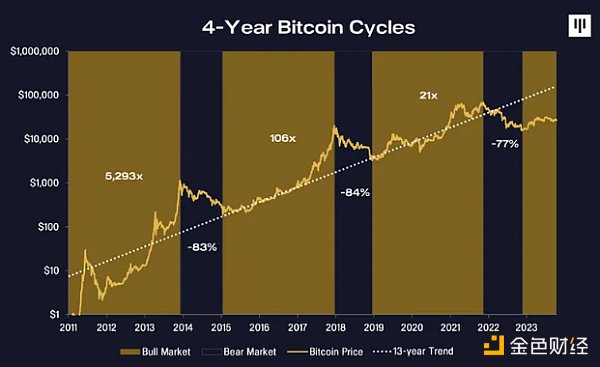
Bitcoin’s four-year price cycle. Source: Pantera
3. Impact on price: in the context of Bitcoin halving
Although the scarcity narrative is important, in addition to the contraction of supply , there are other factors at play. In theory, lower inflation should boost demand, but the actual price impact is likely to be limited.
The slower rate of coin production reduces the inflation rate while ensuring that the supply of Bitcoin remains limited (21 million coins). This non-inflationary nature appeals to cryptocurrency enthusiasts: Unlikefiat currenciesand gold, Bitcoin is not subject to central institutions and natural reserves.
Lower rewards promote the health and sustainability of the network. According to Dig1C0nomist, the annualized energy consumption is 141.46 TWh, equivalent to the energy consumption of the entire Ukraine, and the carbon footprint is similar to Oman (78.90 Mt CO2).
Bitcoin is also affected by factors other than the rate of supply expansion. These factors include drivers within and outside the blockchain industry: regulation, the Federal Reserve’s monetary policy, geopolitics, and more.
According to the efficient market hypothesis (EMH), if all traders are aware of the halving, the effect must already be reflected in the price. However, as Warren Buffett said more than thirty years ago: "Investing in a market where people believe it is efficient is like playing bridge with someone who has been told that there is no benefit to reading the cards."
As Grayscale points out, changes in supply structure are the only certainty. The halving brings Bitcoin close to its maximum supply, creating challenges for all miners.
In other words, Bitcoin’s scarcity is also programmable and therefore known in advance. Models that tie it directly to price increases may be flawed. Otherwise, Litecoin (another cryptocurrency that undergoes halvings) would continue to rise after each halving, which is not the case.
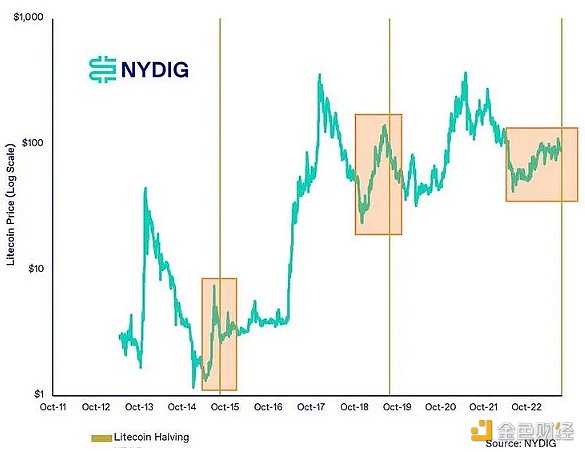
Litecoin’s halving cycle. Source: NYDIG
4. Historical Perspective: Macro Background
Previous halving events have been accompanied by emphasis on the fundamentals of Bitcoin as an alternative store of value, or have helped it factors that benefit indirectly.
In 2012, the European Union was suffering from a profound debt crisis. By November 2013, Bitcoin surged from $12 to $1,100.
2016 was a year of primary coin issuance boom, with more than $5.6 billion flowing into other cryptocurrencies. By December 2017, Bitcoin rose from $650 to $20,000.
Inflation concerns rose in 2020 during the coronavirus pandemic. By November 2021, Bitcoin surged from $8,600 to $68,000 and hit an all-time high of $69,044.77 on November 10. The perception that it is a safe-haven asset plays a significant role.
Bitcoin Halving 2024: Looking for Clues from Past Performance
Past performance is no guarantee of future results, and as we have shown , influencing factors are not limited to cryptocurrencies. However, past halving events provide some clues about possible scenarios.
Time of highs and lows
In theory, Bitcoin rebounds from lows long before the halving, usually after the halving. 12-16 months before the semi-event, according to CoinDesk data. Analysts at Pantera estimate that the bottom usually occurs 477 days before the halving event.
The upward trend will continue before and after the halving. The post-halving rally lasted an average of 480 days (ending at the subsequent bull market high).
This time, the lowest point occurred before the expected date (December 30, 2022). It happened on November 10th ($15,742.44).
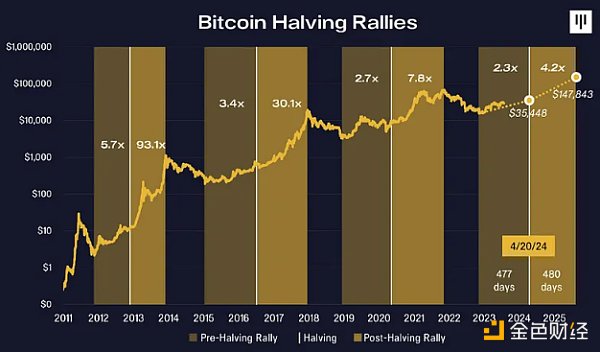
The rebound of the Bitcoin halving market. Source: Pantera
If history repeats itself, according to Pantera’s communications, the market will stop at the end of 2025.
Bitcoin Halving 2024 Prediction: Back to $69,000 Soon?
In the past three halving cycles, Bitcoin has risen by more than 30% in the first eight weeks. As Marcus Thielen, founder of 10x Research, noted, during that time, Bitcoin’s gains averaged 32%.
Given that the current price is $52,456.77, if the same trend repeats, the price will return to the all-time high of $69,000. Thielen added that this possibility increases “the closer we get to Bitcoin’s halving.”
Daily RSI
10xResearch reported on February 19 that the daily RSI (relative strength index) had exceeded 80. This momentum indicator measures the speed and variability of price movements, and when the index reaches 70, it means strong upward momentum.
Historically, when the RSI exceeds 80, it indicates a rise of more than 50% in the next 60 days. The last time Bitcoin’s 14-day RSI reached such highs was in December 2023. As of February 22, it was 70.88%.
5. Bitcoin Halving 2024 and Spot ETFs
This year, Bitcoin’s rise has been supported by the adoption of spot Bitcoin ETFs. To date, these exchange-traded funds, which enable investors to obtain investment income in Bitcoin without directly holding Bitcoin, have attracted a total of more than $5 billion in net inflows.
This inflow of funds not only supports high investor sentiment, but also alleviates the selling pressure caused by block rewards (that is, all newly mined Bitcoins may be sold in full).
According to Grayscale’s calculations, based on the current output of 6.25 Bitcoins per block, the annual selling pressure amounts to $14 billion (based on a price of $43,000). After the 2024 halving, the total will be reduced to $7 billion, so less buying pressure will be needed to offset selling pressure.
The spot Bitcoin ETF has absorbed “almost three months worth of potential post-halving selling pressure.” This took only 15 trading days.
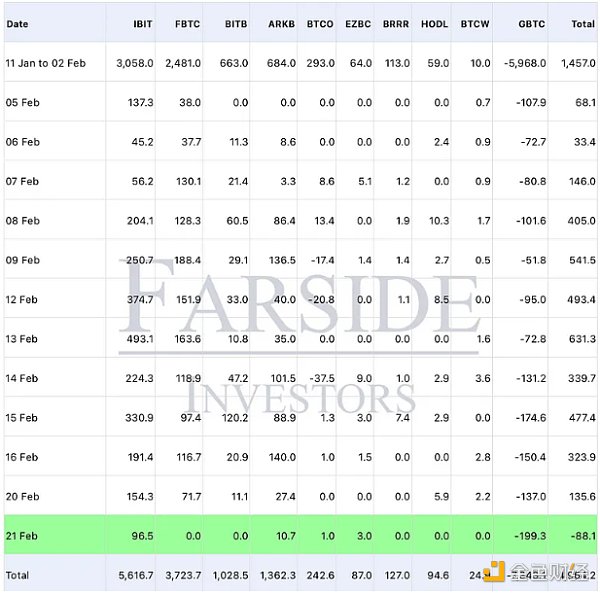
Cumulative inflows into Bitcoin ETFs. Source: Farside Investors
6. Forecast for 2025: The price of Bitcoin after halving will reach US$150,000 to US$200,000
Due to expectations of the market , the market typically rises in the period leading up to Bitcoin’s halving. As of February 22, 2024, experts and research institutions are generally optimistic, predicting that Bitcoin will have an average price range of $150,000 to $200,000 by mid-2025.
Bitcoin’s order book liquidity is at its highest level since October 2023, although below levels before the FTX crash. Unless demand drops (as is currently the case), reducing the supply of new Bitcoin will surely boost its price. Some analysts say a new all-time high has already begun.
Bernstein said that pre-halving behavior reflected the coming supply crunch and growing demand for spot ETFs. The company expects prices to "hit all-time highs in 2024" and peak at $150,000 in mid-2025.
Skybridge Capital founder Anthony Scaramucci expects Bitcoin to reach a high of $170,000 or higher in July 2025. "Whatever the price is on halving day in April, multiply that by four, it will get to that in the next 18 months," he said in an interview with Reuters in January. Price."
Scaramucci used a conservative starting point of $35,000 (the price at the time of the halving) in calculating $170,000. Based on the current price of $52,000, this scenario would take Bitcoin over $200,000.
Meanwhile, according to his long-term estimates, the pioneering cryptocurrency should be worth half the market value of gold. This would require market capitalization to grow from about $1 trillion today to about $6.5 trillion, equivalent to a more than 6-fold increase.
Doubters: More drive needed to reach all-time highs
Rachel Lin, co-founder and CEO of SynFutures, says halving “ "Unlikely to trigger a full-blown bull market" unless cryptocurrency adoption grows significantly, "this alone will not be enough to get Bitcoin back to its peak of nearly $69,000, let alone beyond it."
However, due to the US election, local regulators may be less "headline-seeking" at this critical time. As a result, cryptocurrencies may not have much negative news to dampen investor enthusiasm in the future. This could pave the way for the next bull trend.
Factors to focus on in the short and medium term
The halving is a positive factor in the medium term. CCN’s Peter Henn summarizes the positive and negative factors Bitcoin may face in the coming weeks and months.
Growth in institutional adoption was the main positive factor, along with a price rebound and positive technical indicators. However, adverse changes in regulatory policies and the macroeconomic backdrop, such as rising inflation, may affect market sentiment.
Early warning factors in the medium term include regulatory policy and other competing cryptocurrencies, including central bank digital currencies (CBDC). Hacking attacks and other security breaches can damage trust in the market.
Over the next 1-2 years, Bitcoin is also likely to rise due to improvements to the Lightning Network and its strengthening status as a store of value.
Bitcoin Halving 2024 and Miners
As long as the economic incentives are sufficient, miners will continue to secure the blockchain. Therefore, the Bitcoin price must be high enough to offset the costs during and after the halving.
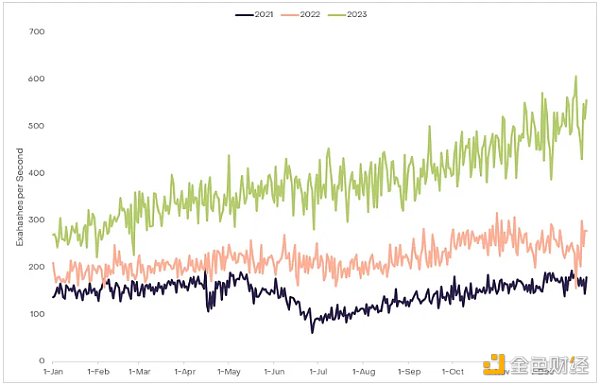
Hashrate reaches all-time high in 2023. Source: Glassnode.
Large miners are actively hoarding Bitcoin, and according to Taras Kulyk, founder of SunnySide Digital, “the halving is already being considered by most companies” because “for years, they have been anticipating and incorporating halving prices into their forecasts”.
At the same time, miners with higher electricity bills and less efficient equipment may eventually have to shut down operations, considering their hardware investments and overhead expenses. Improving operational efficiency will be crucial to continue operating and reaping benefits after the halving.
Methods to improve efficiency include purchasing more advanced equipment, selling Bitcoin holdings on-chain, and conducting equity issuances. Canada-based Hut8, for example, is making its mines more efficient through custom software and looking to acquire more power plants. After its recent merger with USBTC, its hash rate has almost tripled to 7.3 exahashes per second.
Marathon Digital, the number one listed miner based on actual hashrate, launched a hybrid equity offering totaling $750 million. Core Scientific recently closed an oversubscribed $55 million equity financing round to restore debt solvency. The company is also focused on keeping its hardware online, making the most of available equipment.
However, CEO Adam Sullivan believes that the Bitcoin network has "self-healing properties" and will continue to incentivize miners. As more miners shut down and the hash rate drops, the difficulty of the proof of work will also decrease. This can compensate for the increasing speed and fluctuating node running interest.
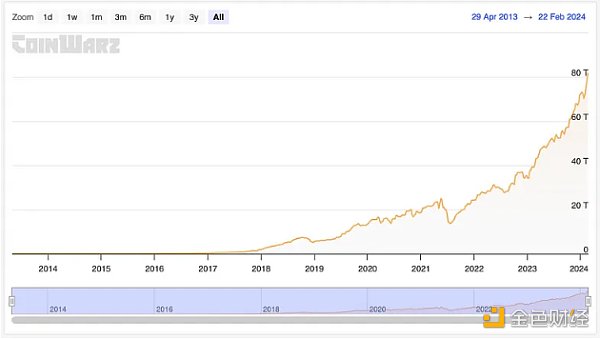
Bitcoin mining difficulty chart. Source: CoinWarz.
Mining difficulty is a moving average of the average number of blocks. When blocks are generated too quickly, the difficulty increases. As a result, the network automatically adjusts, with leavers releasing larger block shares to reward stayers. Mining became even more profitable for the remaining participants.
7. Rising transaction fees and miner income
The 2024 halving will take place after the launch of Bitcoin Ordinals. This protocol supporting Bitcoin NFTs (mementos) brings new use cases, driving an increase in transaction fees and developer activity. These effects provide additional reasons for optimism about the profitability and sustainability of mining.
In November 2023, the Ordinals craze pushed Bitcoin transaction fees to a two-year high (over $37), making them surpass Ethereum’s gas fees. Since then, souvenir fees have accounted for more than 20% of miners' income.
As of February 22, 2024, Bitcoin is one of the top three blockchains in terms of NFT transaction volume. In December 2023, it became the leader. The Ordinals campaign is therefore a novel way to incentivize miners and maintain network security through higher transaction fees.

Growth in Bitcoin Souvenir Fees. Source: Glassnode.
High transaction fees have sent share prices of listed miners soaring. In late 2023, these companies saw huge profits as miners earned almost four times the two-year average.
Since then, the fee has dropped to just over $4. However, mining stocks like Marathon Digital (MARA) and Cleanspark (CLSK) have outperformed Bitcoin over the past three months, rising 116.57% and 231.28% respectively. They may also respond positively to solid stock market performance.
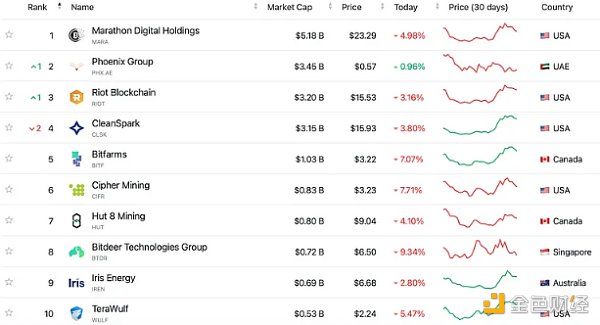
The market capitalization of the top ten Bitcoin mining stocks. Source: companiesmarketcap.com
Top Mining Locations
Measured by cumulative hash rate, according to World Population Review ,In 2023, the United States leads with 35.4%, followed by Kazakhstan (18.1%), Russia (11.23%), Canada (9.55%) and Ireland (4.68%). China was once the second largest mining location, but it banned Bitcoin mining in 2021, causing miners to move to Kazakhstan.
Concerns about environmental restrictions
Bitcoin mining is still extremely unsustainable - in 2023, Bitcoin mining consumes Energy equivalent to the entire Australia, or seven times Google's annual energy consumption (91 terawatt hours).
In the United States, Bitcoin mining’s share of electricity demand ranges from 0.6% to 2.3%, equivalent to the electricity consumption of an entire state, such as Utah. Earlier this year, the U.S. Energy Information Administration required all U.S. miners to report detailed reports on their energy use. The agency's report states:
"Concerns raised with the U.S. Energy Information Administration include stress on the electric network during periods of peak electricity demand, potential electricity price increases, and concerns about energy-related carbon dioxide (CO2) emissions. Impact."
Major news outlets such as The New York Times have drawn attention to the "public hazard" posed by large-scale mining sites. The Biden administration has been critical of cryptocurrencies, with the U.S. Energy Information Administration highlighting that soaring prices have incentivized more mining activity, leading to increased electricity consumption.
Meanwhile, New York state implemented a two-year ban on new mines coming online unless they rely entirely on renewable energy. In Texas, miners are paid when they curtail operations during periods of peak energy demand as part of a "demand response" program.
8. On-chain indicators: positive signs for the long term
Finally, let’s look at two technical indicators that provide an overall view of Bitcoin and potential price action.
MVRV Z-score
MVRV is an oscillator that compares Bitcoin’s market value to its realized value, or its spot price to its realized value Price comparison. This chart visualizes market cycles and profitability, helping to spot periods when coins are undervalued and overvalued.

Bitcoin’s MVRV Z-score chart. Source: lookintobitcoin.com
As the market matures, Bitcoin’s peaks, volatility, and returns become less intense. Against the backdrop of growing adoption of this pioneering digital currency, its realized price growth has slowed compared to past cycles. As a result, incremental gains are more likely than explosive surges and have better long-term growth potential.
At the same time, a large portion of Bitcoin has been accumulated by holders. Supply to long-term holders reached an all-time high at the end of 2023, and whales continued to show confidence in the asset this month.
9. Corridor of the Law of Power
The Corridor of the Law of Power shifts the focus from the current price to whether Bitcoin is overbought or sold. This charting tool creates a channel consisting of two parallel lines at the lower and upper limits of a price range.
A move above the midline indicates an overbought condition, while the opposite indicates an oversold condition. An upward break above the bottom line signals the possibility of further growth, and Bitcoin typically reaches mid-line levels within 1-2 months.
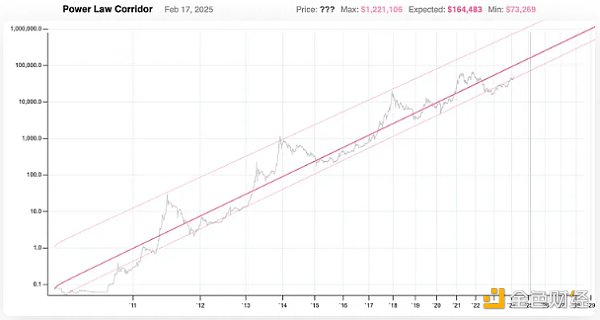
Bitcoin 2024 Halving Price Prediction: Law of Power Corridor Projection for February 17, 2025. Source: bitcoin.craighammell.com
According to James Bull, overbought conditions typically last about 1.5 years (strong bull markets) while massive bear market cycles continue 2.5 years. However, the model also has its detractors. As its creator Harold Christopher Burger stated:
"Acknowledging that Bitcoin follows a power law is temporary. Furthermore, there are other factors besides time "Things that should affect Bitcoin's price, such as its scarcity," however, "In the log-log plots, the power law fits are getting better and better, suggesting that this model may hold."
10. Summary
Before and after each halving, Bitcoin’s price is driven by multiple factors beyond scarcity. The 2024 halving event takes place against the backdrop of massive Bitcoin ETF inflows, increased on-chain activity, strong momentum, and overall market maturity.
As the macro environment improves, including expected interest rate cuts from the Federal Reserve, Bitcoin seems destined to emerge in the corridors of the Law of Power. It has been through its longest bear market, and large miners have braced themselves for the consequences of the halving of rewards.
Our Price Prediction for Bitcoin Halving in 2024
EarnBIT’s analysis team believes that Bitcoin will rise to $55,000 to $60,000 before the halving U.S. dollars, with a full-year range of $32,000 to $85,000. Past performance is no indication of the future, and new black swan events are always possible, but so far the overall environment appears to be conducive to growth.
 JinseFinance
JinseFinance
 JinseFinance
JinseFinance JinseFinance
JinseFinance JinseFinance
JinseFinance JinseFinance
JinseFinance JinseFinance
JinseFinance JinseFinance
JinseFinance JinseFinance
JinseFinance Coindesk
Coindesk Cointelegraph
Cointelegraph Cointelegraph
Cointelegraph